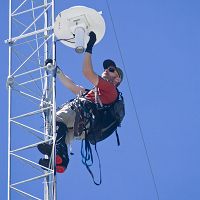Bales et al., 2008
Snow and Soil Moisture Response Across Elevation, Aspect and Canopy Variables in a Mixed-conifer Forest, Southern Sierra Nevada.
Bales, R., Meadows, M., Hopmans, J., Hartsough, P., Kirchner, P. (2008)
Fall meeting, American Geophysical Union, December 2008. 89(53). Abstract C21A-0496.
-
Sierra, INVESTIGATOR
-
Sierra, STAFF
-
Sierra, COLLABORATOR
-
Sierra, INVESTIGATOR
-
Sierra, GRAD STUDENT
Abstract
A water-balance instrument cluster that included over 27 snow-depth measurements and vertical profiles of soil temperature and volumetric water content was deployed in summer and fall of 2007 at the Southern Sierra Critical Zone Observatory (CZO), at an elevation of 1,600-2,000 m. The CZO is co-located with the Kings River Experimental Watersheds, a U.S. Forest Service integrated watershed research site. Instruments were deployed to capture both north- and south-facing aspects, as well as differences in canopy cover across the instrument cluster. Snow on south-facing slopes melted before than on north-facing slopes, resulting in drier, warmer soils after spring snowmelt. Soils in the open dried faster than those at the canopy drip edge, also reflecting earlier snowmelt. Soils reached near saturation during a multi-day summer rain event, followed by more rapid drying of near-surface layers. Soils are largely decomposed granite; however, organic content in near-surface soils influenced measured values of volumetric water content. Macropores, observed at some sites during installation of the soil moisture probes (Echo TE, Decagon) also influenced relative vertical values of soil-water content.
Citation
Bales, R., Meadows, M., Hopmans, J., Hartsough, P., Kirchner, P. (2008): Snow and Soil Moisture Response Across Elevation, Aspect and Canopy Variables in a Mixed-conifer Forest, Southern Sierra Nevada. Fall meeting, American Geophysical Union, December 2008. 89(53). Abstract C21A-0496..
Explore Further





